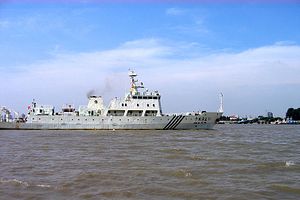On Wednesday, the head of China’s maritime regulator was reported as saying that China had set up a tsunami alert center in the South China Sea.
According to Reuters, Wang Hong, the chief of the State Oceanic Administration, told reporters on the sidelines of China’s annual meeting of parliament that a tsunami alert center had already begun initial operations even though it is still under construction.
“We have already begun issuing tsunami alerts to the international community, including countries on the periphery of the South China Sea,” Wang said. “Cooperation in the South China Sea is one of our important focuses. We hope to collaborate with South China Sea countries and create a peaceful and harmonious sea.”
To the untrained eye, the Reuters article might seem to suggest that this tsunami alert center is a new development with potentially nefarious intentions, particularly given China’s recent behavior in the South China Sea. While some of these assertions can be debated, it is important to get some facts straight first.
First, the idea of a Chinese tsunami alert center is not a new one and has in fact been in the works for years. Following the devastating 2004 Indian Ocean tsunami which killed around 230,000 people across 14 countries, the United Nations Educational, Scientific, and Cultural Organization (UNESCO), largely through its Intergovernmental Oceanographic Commission (IOC), set up the Pacific Tsunami Warning and Mitigation System (PTWS), a network to promote data exchange for rapid tsunami detection. Within this network, alert centers were set up to issue warnings to countries in different areas. For instance, advisories on the South China Sea had been issued on an interim basis by the Pacific Tsunami Warning Center (PTWC) based in Hawaii and the Japan Meteorological Agency (JMA) based in Tokyo.
China then openly offered to build its own tsunami early-warning center in subsequent UN meetings. In September 2013, as was widely reported by Chinese media outlets, Beijing’s proposal to build the center was approved by the assembly of the IOC within UNESCO, and China’s National Marine Environmental Forecasting Center was made responsible for building the center. This is the same center that Wang said is now beginning to issue tsunami alerts to countries, which, by the way, is exactly what it should be doing as part of the PTWS network.
Second, tsunami warning centers typically do not cover one body of water exclusively, and China’s new one appears to not only cover the South China Sea. For example, the U.S.-based PTWC mentioned earlier issues advisories to countries of the Pacific Ocean as well as the South China Sea and Caribbean, while the Japan-based JMA issues advisories for the Northwest Pacific as well as the South China Sea. Up to this point, according to China’s State Oceanic Administration which Wang now heads, Beijing’s new tsunami early-warning center is meant to cover not just the South China Sea, but also the Sulu and Sulawesi Seas. Suggesting that the tsunami early-warning center only covers the South China Sea seems a bit misleading since it suggests a more exclusivist focus that departs from how such centers tend to operate.
Third and finally, while one would not put it past Beijing to use its new tsunami alert center as part of its expansionist agenda in the South China Sea, up to this point it has yet to do so. The Reuters article suggests China may be using the center for “bolstering its jurisdiction in the disputed waters” of the South China Sea, which would be in line with its “assertive pursuit of territory.” And, indeed, given China’s assertive acts there as well as some of its rather laughable justifications for them, it is not too hard to imagine Beijing publicizing the tsunami early-warning center as part of the range of “public services” – as Navy chief Wu Shengli put it last year – that it can provide in the South China Sea with its reclamation and future militarization efforts (Wu interestingly included weather forecasting as well as maritime search and rescue in his list of “public services”).
But there is also the possibility that China’s tsunami early-warning center – which countries approved in late 2013 when its assertiveness in the South China Sea was already quite evident – could serve the purpose that that other such centers now do: helping avert devastating natural disasters under a cooperative framework that could benefit all countries at risk. Given Beijing’s past behavior in the South China Sea, one might be skeptical that this could occur. But just as one should seek to call out China’s wrongful actions in the South China Sea, one should also be cautious about viewing every action Beijing takes as another sign of its ‘assertiveness,’ since that could forestall potentially cooperative endeavors. That requires a careful understanding of Beijing’s moves that go beyond the sensationalist headlines.
































